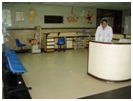DEPARTMENT OF NEONATOLOGY
HISTORY:
The Department of Neonatologyis a tertiary level referral unit that offers best possible perinatal-neonatalservices available in public sector in the country. Itstarted as a 20 bedded unit in 1998. It moved to its present location on third floor of the Emergency Block in February 2000 with improved facilities and increase in its capacity to accommodate 40 babies. The admission rate soared exponentially from 838 in 1999 to 8158 babies per year in 2011. All the babies are out-born with daily admissions ranging from 25 to 50 per day.
It is one of the few departments in country which hold full recognition from
CPSP for training of FCPS in Neonatal Paediatrics.
ORGANIZATION:
The department has following subdivisions:
- In-patients:
- Neonatal Intensive Care Unit
- High Dependency Unit
- Special Care Unit
- Out-patients/perinatal-neonatal/follow-up clinic:
- Twice weekly (Tuesday, Saturday)
- Average of 50-60 patients per week
- Neonatal emergency:
- Located conveniently besides main emergency
- Works 24/7
- Babies transferred to in-patients after stabilization
FACILITIES FOR PATIENTS:
NICU: Total capacity of 8. Equipped with 8 intensive care incubators, 6 ventilators, 2 SiPAP machines, monitors, infusion and syringe pumps, point of care machines, central oxygen, air and vacuum suction, portable x-ray and ultrasound machines. Round the clock services of pharmacist are available for provision of TPN, extemporaneous preparation and aseptic drug dispensing.
SCU: Total capacity of 12. Relatively stable babies kept with mothers for completion of treatment period or awaiting diagnosis.
OUT-PATIENTS/PERINATAL-NEONATAL/FOLLOW-UP CLINIC:
Located conveniently in OPD block of hospital, it is conducted twice weekly for follow-up of discharged babies or advice to high-risk antenatal cases referred from obstetric units of different hospitals.
STAFF:
- Doctors:
- Associate Professor
- Senior Registrars:
- Clinical fellows
- Registrar:
- Nurses
- Para-medical staff:
-
Computer assistant
-
Ward clerk
-
Ward attendants
-
Security guards
-
Ward cleaner
2. Dr. Hafiz Muhammad Anwar
M.B.B.S; DCH; F.C.P.S (Paeds)


FUNCTIONING OF DEPARTMENT:
The main bulk of admissions is from neonatal emergency, which is located and functions as a part of main emergency services of the hospital. The babies are transferred to in-patients after initial stabilization. The babies are reassessed by the doctors on-duty in neonatal unit and placed in various sub-units and managed accordingly.Only the parents are issued security passes and are allowed to enter the unit at any time. There are no visiting hours.The parents are counseled after the clinical rounds at least once a day by the attending doctor.
The patients admitted in Neonatal Unit also benefit from unique and holistic care provided by different sub-specialties and diagnostic services inChildren’s Hospital, all under one roof.
TEACHING ACTIVITIES:
Following training courses are organized on regular basis:
- Neonatal life support
- Neonatal mechanical ventilation
- Insertion of chest drain in pneumothorax
- Life lines in neonates
RESEARCH ACTIVITIES:
Many research papers and case reports have been published in medical journals or presented in
various conferences. The department has also developed research collaboration with Faculty of Life Sciences, Manchester University, UK. The collaborative laboratory in Children’s Hospital became functional in April 2011. The papers published are: –
- ‘Hemolytic disease of the newborn: Can we better meet this challenge?’ Pakistan Paediatric Journal. September 2005. Vol. 29, Issue 3 (129-32).
- ‘Bacterial neonatal sepsis in the developing world’. Pakistan Paediatric Journal. December 2007. Vol. 31, Issue 4 (206-14).
- ‘Is early ultrasound screening for developmental dysplasia of the hip necessary?’ Pakistan Paediatric Journal. June 2008. Vol. 32, Issue 2 (87-93).
- ‘BrachytelephalangicChondrodysplasiaPunctata: A case report’. Pakistan Paediatric Journal. September 2010. Vol. 34, Issue 3 (160-62).
- ‘Evidence Based Guidelines for the Management of Neonatal Respiratory Distress Syndrome (RDS) in Pakistan: Personal Observations and Pragmatic Opinion’. Pakistan Paediatric Journal. December 2010. Vol. 34, Issue 4 (169-79).
- A Child with Robert’s Syndrome. A case report. Journal of the College of Physicians and Surgeons Pakistan 2011:21(7):431-433
CLINICAL AUDITS
The system of clinical audits was also initiated in 2007.Following have been completed and presented:
- Neonatal sepsis: an over-diagnosis
- Neonatal transport
- Oxygen therapy
- Referral system from other hospitals
DEVELOPMENT OF UNIT GUIDELINES AND NEONATAL FORMULARY:
The department is developing its own manual of evidence based guidelines and neonatal formulary.
CONTINUING PROFESSIONAL DEVELOPMENT IN COLLABORATION WITH DEVELOPED COUNTRIES:
A system has been developed for regular visits of neonatologists of international recognition from UK and USA and nursing instructors from UK. The doctors and nurses of the unit have benefitted from their regular visits and teaching.
FUTURE VISION:
- Development of satellite neonatal care centres at tehsil and district levels for provision of neonatal care at door-steps. This will prevent further destabilization of sick babies associated with transport in adverse and uncontrolled environment, improve their outcome and reduce the burden on tertiary centres.
- Development of neonatal transport system.
- Improvement in patient care through indigenous research.
- Expansion of research links with national and international organizations.
- Increase in staff at all levels and improvement in staff with patient ratio.
- Regular short term on-job training for doctors and nurses in level 3 neonatal units of developed countries.
- Improvement in on-site diagnostic facilities e.g. digital x-ray terminal.
- Development of high risk obstetric unit and NICU besides it.
- Strengthening of perinatal-neonatal, preventive and community services.
CONTACT US:
POSTAL ADDRESS:
Department of Neonatology,
The Children’s Hospital & the Institute of Child Health,
Ferozepur Road,
Lahore – 54000
Pakistan
Telephone: 0092 42 99230901-20 Extn: 5006& 4005
E. mail:[email protected]










